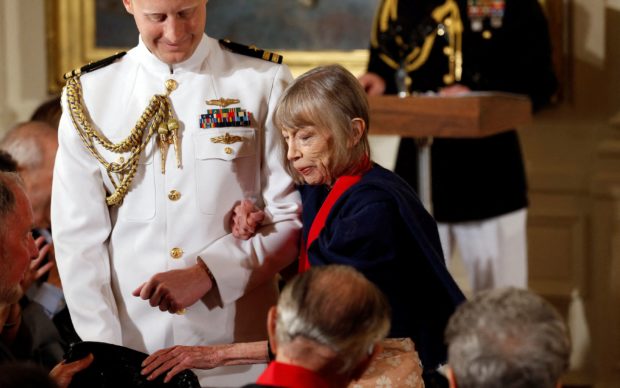Joan Didion, a US literary icon, dead at 87

Writer Joan Didion is escorted to her seat after U.S. President Barack Obama awarded her the 2012 National Humanities Medal during a ceremony at the White House in Washington July 10, 2013. (Reuters)
NEW YORK–Joan Didion, a US literary icon credited with ushering in New Journalism with her essays on Los Angeles life in the tumultuous 1960s, died on Thursday. She was 87.
Known for her piercing insights and understated glamor, Didion died at her home in Manhattan of Parkinson’s disease, the New York Times said, citing her publisher.
Didion’s early work included her seminal 1968 essay collection “Slouching Towards Bethlehem” — which delighted critics and made her a bona fide star — as well as “The White Album,” another essay collection focusing on LA, and “Play It as It Lays,” a novel about Hollywood lives.
Decades after her heyday as a Hollywood socialite, screenwriter, essayist and novelist, Didion found herself again in the spotlight for her searingly honest writing on bereavement following a harrowing double tragedy.
Didion was 69 when her husband and screenwriting partner John Gregory Dunne suffered a fatal heart attack and, less than two years later, the couple’s daughter Quintana Roo was killed at age 39 by acute pancreatitis.
Article continues after this advertisement“This was never supposed to happen to her, I remember thinking — outraged, as if she and I had been promised a special exemption,” Didion wrote in her 2011 memoir “Blue Nights.”
Article continues after this advertisement“When we talk about mortality, we are talking about our children.”
Raised in California’s Sacramento Valley, Didion was a “shy, bookish child,” as she would later put it, who found solace in reading anything she could get her hands on.
She graduated with an English degree from the University of California, Berkeley, and was hired by Vogue after winning an essay competition.
It was while working for the magazine in New York that she met Dunne — a novelist — and the pair married in 1964, just before her 30th birthday.
Didion’s brother Nick was a moderately successful movie producer, and the couple joined him in Los Angeles in June 1964, renting a house owned by the widow of Oscar-winning “Citizen Kane” co-writer Herman J. Mankiewicz.
By then Didion had already written a first novel, “Run River,” but was not yet the cult figure she would become.
The couple threw themselves wholeheartedly into the celebrity party scene, enjoying nights out with Warren Beatty, Natalie Wood and Barbra Streisand, and meanwhile adopting their newborn daughter.
‘Kiss of death’
Noted for her sanguine but seductive prose, Didion wrote in her first column for Life magazine in 1969 that she and Dunne were at the Royal Hawaiian hotel in Honolulu “in lieu of filing for divorce.”
A pioneer of the New Journalism school of literary non-fiction, Didion shone a light on the values of a city where Old Hollywood was being usurped by the less innocent counterculture of “Easy Rider” and the Manson Family murders, with movies overtaking music as the hot art form.
Didion and Dunne embarked on a screenwriting partnership beginning with “The Panic in Needle Park” in 1971 and taking in “A Star is Born” (1976) with Streisand and Kris Kristofferson, and “Up Close and Personal” (1996), starring Robert Redford and Michelle Pfeiffer.
She wrote five novels, 13 works of non-fiction and six screenplays, and while her days as a “cool” celebrity were largely behind her, Dunne’s death in 2003 sparked something of a renaissance.
“The Year of Magical Thinking” — Didion’s 2005 dissection of the trauma of losing her husband — won a host of awards and sold more than a million copies.
“Blue Nights,” which explored the more devastating blow of losing Quintana Roo, was described by the late writer Christopher Hitchens as a work of “intense dignity and courage.”
Didion again made headlines in 2015 when luxury French brand Celine used a picture for an ad campaign showing her with silver hair styled into a bob, clad in black with huge sunglasses — an icon once more in her ninth decade.
“What she is, is a femme fatale, and irresistible,” novelist Lili Anolik noted in a profile for Vanity Fair in 2016.
“She’s our kiss of death, yet we open our mouths, kiss back.”